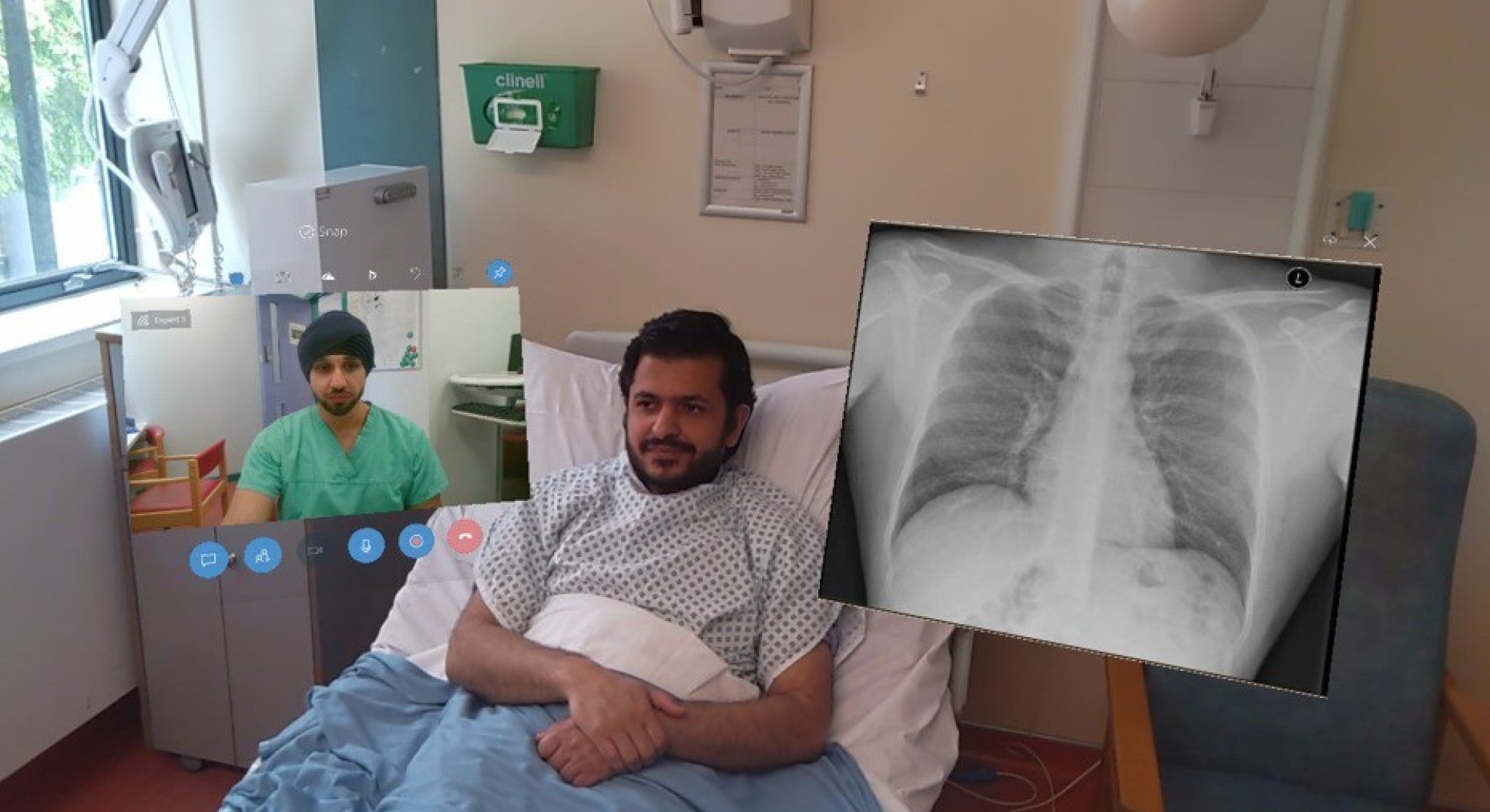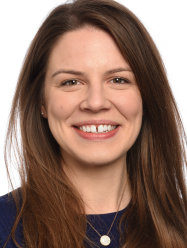
Dr Louis Koiza wears the HoloLens on site at St Mary’s Hospital (Photo: Thomas Angus)

Medical students experience teaching via a video feed, and are able to witness and interact with real-time exchanges between clinicians and patients.
Head of the School of Medicine, Professor Amir Sam, said: “The COVID-19 pandemic has resulted in the first time in living memory that medical education has been truly limited by having no access to patients. The mixed-reality technology and the virtual clinical experiences it provides means this will never have to be the case again.
“I am very grateful to Dr James Kinross for pioneering the use of this technology in delivering direct clinical care, to the School of Medicine's Digital Learning and Information Governance teams, and to the College’s Digital Learning Hub for their invaluable support bringing this innovation to fruition.
“We ran positive pilot sessions over the summer, and now have delivered successfully both medical ward round teaching and, most recently, surgical teaching. We are excited to deliver increasing amounts of our education in this way.”
The mixed-reality technology enables the clinical live stream to be supplemented visually with digital information, such as the patient’s drug charts and treatment information or radiographs, which can be superimposed as holograms onto the environment.
The HoloLens allows the wearer to record their teaching sessions, ensuring the School can offer an ever-expanding library of cases, clinical interactions and knowledge for its students that is available at any time.
Placement parity
Parity of clinical placements is an ongoing challenge for medical schools – one which mixed-reality technology will provide a timely solution for, with the ability to demonstrate important medical conditions and their management to an entire cohort at once.
Previously, ward rounds may only have been able to accommodate reliably two or three students, and content was heavily dependent on the nature of the cases that had been admitted to the ward.
Using the headset, the School’s clinician teachers can now deliver a planned session to as many students as needed.

Professor Sam said, “Ensuring every student is rotated through a similar experience of clinical placements in their time at medical school – that is to say, to ensure each of them has seen a comparable case mix – is practically challenging.
“Teaching with the HoloLens allows us to guarantee a level of exposure for our students to a far greater range of patients and medical conditions than ever before.”
Centres of excellence
With increasing centralisation of healthcare delivery, centres of excellence at our affiliated hospitals are seeing growing numbers of patients
“The School of Medicine takes huge pride in its close relationship with these centres and the world-class doctors and researchers that teach our students. We are excited to have developed a means to harness that excellence and ensure its integration in the education of future doctors,” added Professor Sam.
In the run-up to the pilot ward round with real patients before the summer, Professor Sam also acted as a simulated patient to understand the experience from the patient perspective: “The clinician was able to interact with me in the usual way, as well as engaging with and teaching the students. The human interaction was not lost through the use of the headset.
“The experience may also be preferred by some patients, as they need not be surrounded by a large group of people during the consultation.”
The HoloLens has also been successfully introduced for clinicians working on high-risk wards at Imperial College Healthcare NHS Trust hospitals during the height of the COVID-19 pandemic. The technology helps ensure that unnecessary exposure to infections can be minimised, and that students as well as other doctors can learn from frontline medics in real time should a similar outbreak occur in future.
The use of the HoloLens and augmented reality has also been explored for surgical use, initially demonstrated on patients undergoing reconstructive lower limb surgery.
Student focus
Oliver Salazar, a medical student intercalating at Imperial, was part of the inaugural round: “The virtual ward round was an invaluable clinical experience as it removes barriers, such as COVID-19, in accessing patients ‘face-to-face’.
“Despite the ward round being virtual, it felt far from it – we were expected to ask questions and think about clinical problems in real time. It was really helpful to be able to access investigations, like x-rays and blood tests, in an instant, and the way the information was projected felt natural.
“As a fifth year student, the ward round was very comparable to a traditional physical session. However, it felt an excellent bridge to seeing patients, and provided a safe environment to ask questions and discuss learning points with the doctor wearing the headset.”
Historically, Grand Rounds — where a patient, their case and relevant treatment information would be presented to an audience of clinicians and students — might have seen a patient wheeled into an amphitheatre to be discussed, and sometimes questioned.
As student numbers grew, the approach became less and less feasible.
This reversal of how education is delivered – with a teacher able to take 50-60 students to a patient, rather than the patient to 50-60 students – signals a major change in the management and overall quality of clinical teaching.
The HoloLens headset also facilitates the delivery of a planned session with a higher level of engagement from both teacher and student than can always be consistent in a clinical environment.
“When you’re communicating via the headset, you have to be precise and planned in your teaching,” Professor Sam explained.
“Even in a busy clinical environment, the technology allows you to put the students at the centre of your teaching, and ensure their interactions and discussions are more detailed, more involved and simply more enjoyable.”

The educational benefits extend into the students’ professional skills and behaviours, with the opportunity to develop communication skills through observing and analysing interactions during recorded sessions.
Professor Sam said: “We have used simulated patients in clinical teaching to great effect, but everyone involved knows the patient isn’t ‘real’, and you can lose the complexities of real-life clinical practice in scripted sessions. There is a phenomenal range of subtleties in any given clinical interaction, and students will be able to witness a huge amount more of these between clinician and patient than ever before.”
Digital Integration
The School of Medicine recently appointed Dr Risheka Walls to lead on the integration of mixed-reality technology in the undergraduate medicine curriculum.
Dr Walls also highlighted the importance of ensuring the interactivity with real patients: “If there was ever a time to revive William Osler’s bedside teaching, then now is that time. With human interaction such a precious commodity, students want live, interactive bedside teaching with real patients and real clinical signs at their fingertips.
“Augmented reality teaching with HoloLens has made this possible and our students love what they see.”
Dr Walls also praised the numerous teams who have come together to make the project happen: “The opportunity to launch these innovative, real-time tutorials to our undergraduates has been an exciting challenge and I am very proud to have worked with our dedicated Digital Teaching Fellows and fantastic colleagues in Education Technology, ICT, Learning Design, our affiliated NHS Trusts and as a partner with Microsoft to make this happen.
“In my new role, this is just one of the many ways I aim to bring our undergraduate teaching to life – literally!”
Global possibilities
Professor Sam is confident this innovation is just the beginning as he looks to the future of medical education more broadly.
“What we would like to see is our teaching methodologies driving technology rather than the limits of the technology dictating our creative boundaries. Technology will simply be the tool by which our pedagogical aims are delivered.
"We’ll be able to offer education for a broader community. Local, national, international – Imperial’s quality teaching can be beamed around the world. Medical educators and doctors globally can benefit from resources provided by Imperial and the affiliated centres of excellence. We’ll be able to provide medical education and share knowledge in an entirely new way, hopefully to incredible results.”
Professor Sam would like to extend specific thanks to Professor Liz Hughes, Deputy Medical Director, Health Education England; the Faculty of Medicine Education Office’s Lisa Carrier, Head of Technology-Enhanced Education; Adrian Cowell, Senior Learning Technologist; and Tom Yates, Information Governance Manager.
Article text (excluding photos or graphics) © Imperial College London.
Photos and graphics subject to third party copyright used with permission or © Imperial College London.
Reporter

Dorrit Pollard-Davey
Faculty of Medicine Centre

Contact details
Tel: +44 (0)20 7594 7703
Email: d.pollard-davey@imperial.ac.uk
Show all stories by this author



